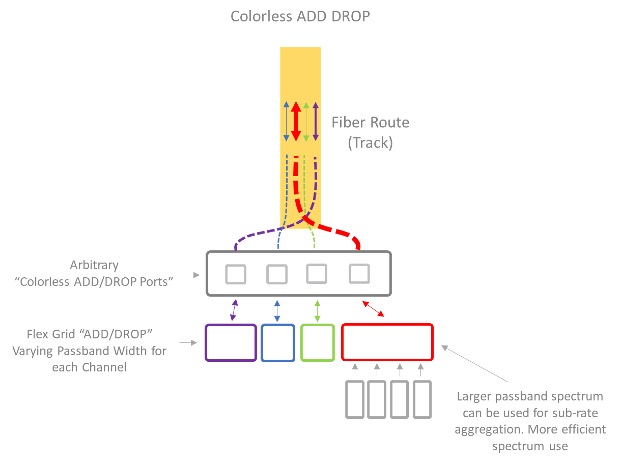Flexible, Intelligent CDCF Networking
Flexible grid
Flexible grid enables different-sized trains to operate side by side on the same fiber route. We’re going to break our train track as a fiber analogy a little for this one. Instead, assume that multiple tracks are carried over the same fiber. Originally, each of these tracks and their trains had the same standard width of 50GHz (fixed grid). In a flex grid system, “fatter” and “wider” trains that can carry more load (increased data rate) can operate side by side with the standard 50GHz trains and tracks. Additional capacity is also increased by reducing the gap between side-by-side tracks. Putting more tracks in this free space without buying more land means better spectral efficiency and more usable bandwidth over the same fiber pair.
The flexibility to broaden this “passband” beyond the standard 50 GHz (88/96 Ch) and 100 GHz (40/44 Ch) allows us to take advantage of the high-speed, high-performance coherent transceivers such as 400, 600, 800 and future 1.2 Tbit/s. Moving to flex grid and larger load carrying trains allows the ability to carry multiple smaller independent trains such as 100 Gig and 400 Gig. Flex grid also allows for the frequency passband of each channel to be variable and adjustable remotely via software. Taking advantage of coherent transceivers and the spectral efficiency they offer leads to an increase in overall fiber route capacity while simultaneously lowering power consumption, equipment footprint and the critical cost per bit metric.

Figure 4: Flexible grid
(click to enlarge)
Controlling and managing signals at the optical level provides an operationally optimized network by simplifying provisioning, reducing installation intervals, eliminating excess network elements, and increasing service reliability. One of the keys is to integrate these newer state-of-the-art upgrades alongside the existing network. Windstream is one such company to fully embrace these technologies with a nationwide network upgrade that incorporates Ciena’s coherent optical technologies.
The ROADMs that Windstream is deploying will integrate well with the existing flex grid network and increase the overall capacity (including 400 GbE wavelength services) using both C and L bands. As noted above, CDCF provides extreme network capacity through efficient use of the existing fiber plant. Beyond the network flexibility and capacity, Windstream is also deploying Layer 0 analytics to monitor and manage services at the photonic level. Advances such as automatic link calibration and automatic fiber characterization help to combine engineering innovation with daily operational benefits.
The future continues to drive towards a one-size-doesn’t-fit-all approach, and the new platform discussed here enables network providers to customize scalable solutions for their end users. Choosing the right partner who continually invests in advanced network technologies helps ensure that their customers are also ready for the future. At Windstream, we marry a passion for state-of-the-art technology with practical, customer focused engineering.



















